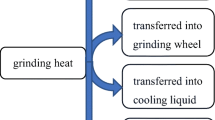Abstract
Hardening layer with a certain thickness can be formed on the workpiece surface after grind-hardening process. It can provide a better using performance for the workpiece. Therefore, the study on surface hardening layer and its distribution has important meaning to improve the using performance of the workpiece after dry grinding process. The paper analyzed the hardness, thickness, and its consistency of hardening layer through grind-hardening experiment using 40Cr and 45 steel. And then the paper studied the temperature field of surface hardening layer on the workpiece by FEM simulation. The cooling rate v mc could be calculated by using temperature–time curve. The distribution of hardness and thickness of surface hardening layer was also obtained. Combined with experiment results, the characteristic of the consistency of surface hardening layer was analyzed. The result showed that the hardness of the surface hardening layer would increase with the increasing of depth of cut a p and feeding rate v w. The thickness of the surface hardening layer also increases with the increasing of a p, but it decreases with the increasing of v w. The Cr element benefited the formation of martensite when the depth of the cut is small. But when the depth of the cut reaches to a certain value, the effect of Cr element could no longer be obvious. The results also showed that the consistency of intermediate area on the workpiece is much better than that of the cutting-in area and cutting-out area. Therefore, in order to obtain surface hardening layer with the suitable hardness and thickness, both technological parameters and materials should be chosen appropriately.
Similar content being viewed by others
References
Brinksmeier E, Brockhoff T (1996) Utilization of grinding heat as a new heat treatment process. CIRP Ann Manuf Technol 45(1):283–286
Brockhoff T (1999) Grind-hardening: A comprehensive view. CIRP Ann Manuf Technol 48(1):255–260
Liu JD, Zhuang JZ, Huang SW (2011) Influence of the grinding pass on microstructure and its uniformity of the grind-hardened layer. Adv Mater Res 36(211-212):36–39
Zarudi I, Zhang LC (2002) Mechanical property improvement of quenchable steel by grinding. J Mater Sci 37(18):3935–3943
Alonso U, Ortega N, Sanchez JA, Pombo I, Izquierdo B, Plaza S (2015) Hardness control of grind-hardening and finishing grinding by means of area-based specific energy. Int J Mach Tools Manuf 88:24–33
Zou JF, Pei HJ, Hua CL, Jiao B, Wang GC (2015) Residual stress distribution at grind-hardening layer surface of the 40Cr workpiece. Mater Res Innov 19:580–584
Zhang JH, Ge PQ, Zhang L, Yu Y, Li H (2010) Study on the friction and wear behavior of grind-hardened layer. Key Eng Mater 431-432:385–388
Jin M, Lian JS, Jiang ZH (2006) A new mathematical model describing hardenability of steels. Acta Metall Sin 42(3):265–272
Fu DZ, Lin HG (1973) Hardenability handbook of steels. China Machine Press, Beijing
Chen JR, Tao YQ, Wang HG (1997) A study on heat conduction with variable phase transformation composition during quench hardening. J Mater Process Technol 63:554–558
Cui ZQ, Tan YC (2008) Metallography and heat treatment. China Machine Press, Beijing
Fu TL, Wang RQ, Wang ZD, Wang GD, Wang MT (2010) Construction and application of quenching critical cooling rate model. J Iron Steel Res Int 17(3):40–45
Zhang X, Liu GQ, Song YP, Wu K (2007) Prediction of spatial distributions of cooling rate, microstructure and hardness in steel components. J Iron Steel Res 19(12):49–52
Maynier PH, Dollet J, Bastien P (1978) Prediction of microstructure via empirical formulae based on CCT diagrams. In: Doane DV, Kirkaldy JS (eds) Hardenability concepts with application to steel. AIME, New York, p 163–178
Yao X, Gu JF, Hu MJ, Zhu ZC (2004) A numerical study of an insulating end-quench test for high hardenability steels. Scand J Metall 33(2):98–104
Li MV, Niebuhr DV, Meekisho LL, Atteridge DG (1998) Computational model for the prediction of steel hardenability. Metall Mater Trans B Process Metall Mater Process Sci 29(3):661–672
Xu ZY, Li XM (1983) Diffusion of carbon during the formation of low-carbon martensite. Acta Metall Sin 19(2):A83–A88
Zhang ZG (2010) Study on grind-hardening temperature field and process parameter determination method. Dissertation, Shandong University
Guo C, Wu Y, Varghese V, Malkin S (1999) Temperatures and energy partition for grinding with vitrified CBN wheels. Ann CIRP 48(1):247–250
Li BM, Zhao B (2003) Modern grinding technology. China Machine Press, Beijing
Lavine AS (1988) A simple model for convective cooling during the grinding process. ASME J Eng Ind 110(1):1–6
Xia QL, Zhou ZX, Huang XM, Yang QW (2010) Simulation and comparison of thermal resource model in surface grinding. Computer Simul 27(1):297–300
Kessler O, Brockhoff T, Hoffmann F, Brinksmeier E, Mayr P (1998) Distortion through surface hardening by grinding. HTM Haerteri Tech Mitt 53(1):9–13
Fujita T, Ochi T, Tarui T (2007) Prediction of hardness distribution in forged steel by neural network model. Nippon Steel Tech Rep 96:57–61
Author information
Authors and Affiliations
Corresponding author
Rights and permissions
About this article
Cite this article
Zhang, X., Xiu, S. & Shi, X. Study on the distribution of hardening layer of 40Cr and 45 steel workpiece in grind-hardening process based on simulation and experiment. Int J Adv Manuf Technol 93, 4265–4283 (2017). https://doi.org/10.1007/s00170-017-0819-7
Received:
Accepted:
Published:
Issue Date:
DOI: https://doi.org/10.1007/s00170-017-0819-7



